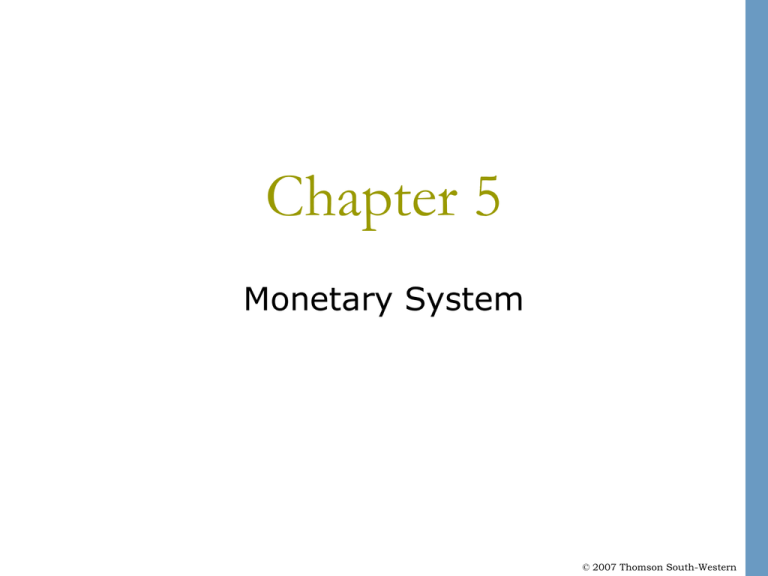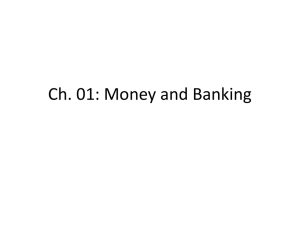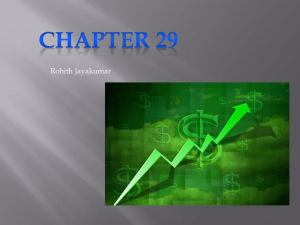money supply
advertisement

Chapter 5 Monetary System © 2007 Thomson South-Western THE MEANING OF MONEY 1. Money is anything that is generally accepted in payment for goods or services or in the repayment of debts. Money is a stock concept. THE MEANING OF MONEY 2. Income is a flow concept. Compare 1. Mehmet’s income is 1000 YTL/month. (flow) 2. Mehmet has 1000 YTL in his account. (stock) 3. Wealth is the total collection (stock) of pieces of property that serve to store value. Currency, gold, cars, houses, land, stocks, bonds, yachts, antiques, factories, hotels, etc. Some of these are not money because they are not as liquid as money. The Functions of Money Liquidity is the ease with which an asset can be converted into cash. Money is the most liquid asset because money is the medium of exchange. Then, in the order of decreasing liquidity comes gold, silver, stocks, bonds, cars, houses, land, antique. Liquidity is desirable because it takes time and costs money to convert other assets into cash. For example, think about selling a house: takes time and need to pay commission to real estate agent. The Functions of Money 1. Functions of Money: Medium of exchange A medium of exchange is anything that is accepted as payment for goods and services. Imagine an economy without money. Then we have to use a barter (takas) system. The Functions of Money 1. Medium of exchange (cont’d) For example, I teach economics and I am hungry. I need to buy bread. If there is no money, how am I going to pay the baker? For everything I want to buy, I need to find a seller that wants to buy my services. This is called double coincidence of wants. It makes exchange very difficult. Money makes exchange much easier than barter because everybody accepts money as payment. The Functions of Money 2. Unit of Account A unit of account is the yardstick people use to measure value of goods and services. What is the value of a projector if we cannot use money as a measure of value? 20 computers? Then what is the value of a computer? The Functions of Money 3. Store of Value A store of value is an item that people can use to transfer purchasing power from the present to the future. Money is not the only asset to store value. In fact money loses value because of inflation. Gold, stocks, bonds, houses, land are better stores of value because they increase in value by the time. But then why do people hold any money? The Functions of Money Because money is the most liquid of all assets. Other assets are more difficult to use in purchases. If inflation increases, people hold less money. They buy other assets to store value. The Kinds of Money Commodity money is a commodity with intrinsic value (i.e. also provides other services) that is used as money. More common in history. Examples: Gold, paper money convertible into gold, silver, cigarettes in prison. Fiat money is used as money only because of government order. It does not have any intrinsic value. Fiat money is unbacked currency. It is not convertible into a certain amount of precious metals as was the case in “gold standard”. Examples: Paper money today, checkable deposits. Money Supply Currency is the paper bills and coins circulating in the hands of the public. But we can also use debit cards and credit cards for payment. Are these also money? In debit cards, payment is done from your checking account deposit. In credit cards, you are borrowing from the bank that issued the card. So debit cards or checks are money. But credit cards are not money, they are credit. Money Supply Checkable deposits (checking account deposits) are balances in bank accounts that depositors can withdraw easily from the ATM machines or write a check upon them for payments. Central Bank Central Bank It is designed to monitor the banking system. It regulates the quantity of money in the economy. Central Bank. Three Primary Functions of the Central Bank Regulates banks to ensure they follow laws intended to promote safe and sound banking practices. Prevent excessive risk taking by commercial banks. Ex: required reserves Acts as a lender of last resort, making discount loans to banks. Conducts monetary policy by controlling the money supply. Central Bank The money supply refers to the quantity of money available in the economy. Monetary policy is the management of the money supply by policymakers in the central bank. Central Bank’s Policy Instruments Open Market Operations The money supply is the quantity of money available in the economy. The primary way in which the CB changes the money supply is through open market operations. The CB purchases and sells government bonds. Does O.M.O. with the banking system. Central Bank’s Monetary Policy Tools Open-Market Operations To increase the money supply, the Fed buys government bonds from the banking system: Open Market Purchase. To decrease the money supply, the Fed sells government bonds to the banking system: Open Market Sale. BANKS AND THE MONEY SUPPLY Banks can influence the quantity of demand deposits in the economy and the money supply. BANKS AND THE MONEY SUPPLY Reserves are deposits that banks have received from depositors but have not loaned out to firms. In a fractional-reserve banking system, banks hold only a fraction of the money deposited as reserves and lend out the rest of the money as loans (credit). BANKS AND THE MONEY SUPPLY The required reserve ratio is the fraction of deposits that banks must hold as reserves by law. Money Creation with FractionalReserve Banking When a bank makes a loan from its reserves, the money supply increases. The money supply is affected by the amount deposited in banks and the amount that banks lend. Deposits into a bank are recorded as both assets and liabilities. The percentage of total deposits that a bank has to keep as reserves at the CB is called the required reserve ratio (RRR). Loans become an asset to the bank. Money Creation with FractionalReserve Banking This T-Account shows a bank that… First National Bank Assets accepts deposits, Reserves keeps a portion $10.00 as reserves, and lends out Loans the rest. $90.00 Assumes that RRR is 10%. Total Assets $100.00 Liabilities Deposits $100.00 Total Liabilities $100.00 Money Creation with FractionalReserve Banking When one bank loans money, that money is generally deposited into another bank. This creates more deposits and more reserves to be lent out. When a bank makes a loan from its reserves, the money supply increases. The Money Multiplier How much money is eventually created by the new deposit in this economy? The Money Multiplier The money multiplier is the amount of money the banking system generates with each lira increase of reserves. The Money Multiplier Increase in the Money Supply = $190.00! First National Bank Assets Reserves $10.00 Liabilities Deposits $100.00 Loans Second National Bank Assets Reserves $9.00 Liabilities Deposits $90.00 Loans $90.00 Total Assets Total Liabilities $100.00 $100.00 $81.00 Total Assets $90.00 Total Liabilities $90.00 The Money Multiplier Original deposit = 100 TL 1st N.B. Lending = 90.00 (=.9 x 100) 2nd N.B. Lending = 81.00 (=.9 x 90) 3rd N.B. Lending = 72.90 (=.9 x 81) … and on until there are just pennies left to lend! Total money supply created by this 100 TL deposit is 1000 TL (= (1/0.1) x 100) The Money Multiplier The money multiplier is the reciprocal of the required reserve ratio (RRR): Multiplier = 1/RRR Example: With a reserve requirement, RRR = 20% or .2: The money multiplier is 1/.2 = 5. CB’s Tools of Monetary Policy Interbank overnight (O/N) rate (called Federal Funds Rate in US) is the interest rate on overnight loans of reserves from one bank to another. It is the price of reserves in the market where banks borrow from each other’s accounts at the CB overnight. Primary instrument of CB’s monetary policy. CB has three monetary policy tools to influence the interbank overnight rate: Open-market operations Changing the reserve requirement Changing the discount rate (MLR) CB’s Tools of Monetary Policy Open-Market Operations CB conducts open market operations when it buys government bonds from or sells government bonds to the banking system: When CB sells government bonds, reserves decreases, money supply decreases and interbank O/N rate increases: open market sale. When CB buys government bonds, reserves increase, money supply increases and interbank O/N rate decreases: open market purchase CB’s Tools of Monetary Policy Reserve Requirements CB also influences the money supply by changing the required reserve ratio. RRR is the minimum amount of reserves that banks must hold as a percentage of total deposits. CB’s Tools of Monetary Control Changing the Reserve Requirement Increasing the RRR increases reserve demand of banks, increases interbank O/N rate, decreases the money supply. Decreasing the RRR decreases reserve demand of banks, decreases interbank O/N rate, increases the money supply. CB’s Tools of Monetary Control Changing the Marginal Lending Rate (Discount Rate) The discount rate is the interest rate CB charges banks for loans. Increasing the discount rate makes it more expensive to borrow from the CB, decreases the money supply. Decreasing the discount rate makes it cheaper to borrow the CB and possibly decrease the interbank O/N rate and increases the money supply. Problems in Controlling the Money Supply CB’s control of the money supply is not precise. CB must deal with two problems that arise due to fractional-reserve banking. CB does not control the percentage of their money that households choose to hold as deposits in banks and the percentage they want to hold as cash. CB does not control the amount of money that bankers choose to lend. Banks may hold more than required reserves: excess reserves. CB cannot control the amount of excess reserves.







